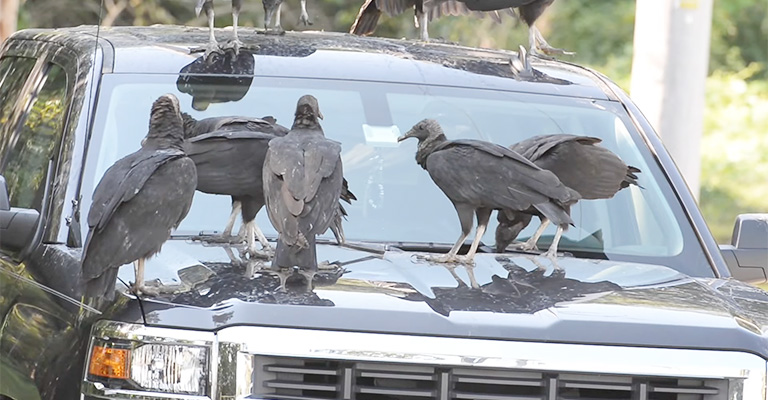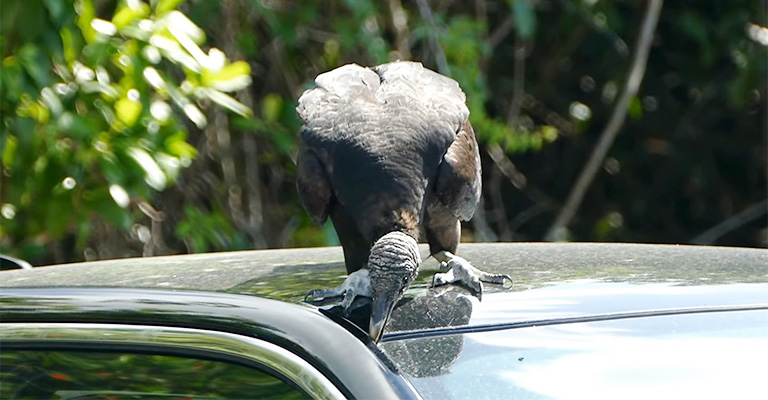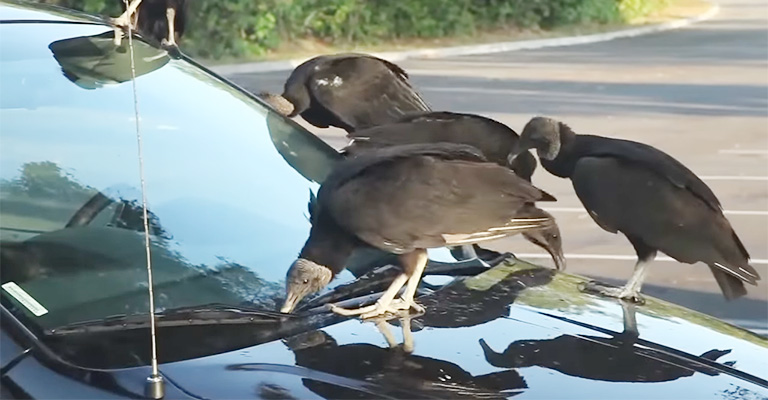Vultures, those majestic and often misunderstood birds of prey, have long captured the fascination of naturalists and wildlife enthusiasts.
However, in recent times, an unusual behavior has emerged that raises eyebrows and curiosity alike: Why are vultures attracted to rubber on vehicles?
From windshield wipers to door seals, these scavengers exhibit an unexpected interest in our cars. But why? This blog post seeks to delve into the intriguing phenomenon, shedding light on the reasons behind vultures’ peculiar attraction to rubber on vehicles.
We’ll uncover the biological and ecological factors driving this behavior and explore the consequences it may have for both vultures and vehicle owners.
So, fasten your seatbelts as we try to understand the world of vultures and the enigmatic allure they find in rubber on vehicles. Stay focused.

Vultures As Scavengers
Vultures play a crucial role in ecosystems as scavengers. These remarkable birds are nature’s clean-up crew, specializing in the disposal of carrion or dead animal remains. Their exceptional adaptations make them well-suited for this task.
Scavengers in Ecosystems
- Vultures hold a crucial ecological role as scavengers.
- They act as nature’s clean-up crew, specializing in the disposal of carrion or the remains of dead animals.
Remarkable Adaptations
- Vultures possess remarkable adaptations that make them well-suited for their scavenging task.
- They have keen eyesight, allowing them to spot carcasses from high in the sky.
- Their strong beaks are capable of tearing through tough animal hides and sinews.
- Vultures also possess highly corrosive stomach acid, which effectively neutralizes harmful pathogens present in decaying flesh.
Disease Prevention
- Vultures play a crucial role in maintaining ecosystem health by swiftly consuming and disposing of carrion.
- Their rapid consumption of carcasses helps prevent the spread of diseases.
- By minimizing the presence of disease-carrying carcasses, vultures contribute to the overall well-being of other wildlife and even reduce the risk of diseases spreading to humans who might come into contact with infected remains.
Conservation Challenges
- Unfortunately, vultures face significant threats such as habitat loss and poisoning.
- These challenges underscore the importance of conserving vulture populations.
- Vultures are often misunderstood, but their conservation is vital for preserving the health and balance of our natural environments.
So, vultures’ unique adaptations and critical role as scavengers contribute to the health and balance of ecosystems by preventing disease outbreaks.
Why Are Vultures Attracted to Rubber on Vehicles?

Vultures are attracted to rubber on vehicles, such as windshield wiper blades and rubber seals, for a specific reason – they resemble the texture and appearance of animal carcasses.
Vultures have evolved to spot potential food sources from high in the sky, and their keen eyesight helps them detect objects that mimic the features of dead animals. Rubber on vehicles can appear glossy and dark, resembling the shiny and darkened skin of a decomposing carcass.
When vultures see these rubber components, they may mistake them for a potential meal and swoop down to investigate. This behavior is an example of how their natural instincts for scavenging can sometimes lead them to interact with man-made objects.
While this behavior can be amusing to observe, it can also lead to damage to vehicles and pose safety risks for both vultures and drivers. Efforts to deter vultures from landing on vehicles often involve using visual deterrents or protective coverings to ensure the safety of both the birds and motorists.
Reasons for Vultures’ Obsession on Rubber
Vultures’ obsession with rubber on vehicles, particularly windshield wiper blades and rubber seals, is not a genuine attraction but rather a result of misidentification driven by their scavenging instincts. There are a few reasons behind this phenomenon:
Resemblance to Carrion
Vultures have evolved to spot potential food sources from great heights. The dark, glossy appearance of rubber components on vehicles can sometimes resemble the texture and color of dead animal carcasses. Their keen eyesight may lead them to mistake these parts for potential meals.
Shiny Objects
Vultures are naturally drawn to shiny or reflective objects. The glare from glass or shiny chrome on vehicles might catch their attention, making them investigate the vehicle more closely.
Heightened Sensory Perception
Vultures have a strong sense of smell and can detect the scent of carrion from significant distances. While they primarily rely on their sense of smell to locate food, the visual cues from rubber components may complement their search, especially when flying over a large area.
It’s important to note that vultures do not have a genuine “obsession” with rubber but are simply responding to visual cues and instincts developed through millions of years of scavenging evolution.
How Do Vultures Damage the Vehicle with Rubber?

Vultures can indeed damage vehicles, including rubber components like windshield wiper blades and seals, although this damage typically occurs as a result of their landing and perching behavior rather than any intentional destructive action. Here’s how vultures can potentially cause harm to vehicles:
Scratching and Pecking
When vultures land on vehicles, they may use their sharp talons to gain a better grip. This can lead to scratches and abrasions on the vehicle’s surface, particularly on the paint, glass, or rubber components like door seals and wiper blades.
Their beaks, while not designed for tearing apart rubber, can still cause minor damage if they peck at these parts in search of food.
Weight and Pressure
Vultures are large and heavy birds, often weighing between 5 to 15 pounds or more. When they perch on vehicles, their weight can exert considerable pressure on the rubber parts they land on.
Over time, this pressure can lead to deformation and weakening of the rubber, especially in the case of wiper blades and weatherstripping seals.
Prolonged pressure can cause the rubber to lose its shape, which can result in reduced sealing effectiveness, increased wind noise, and even water leaks into the vehicle’s interior.
Accumulated Droppings
Vultures, like all birds, defecate regularly. When they roost on vehicles, their droppings can accumulate on the car’s surfaces, including rubber components. Bird droppings contain uric acid, which is corrosive and can damage rubber and paint over time if not cleaned promptly.
The acid can cause rubber to deteriorate, crack, and become less effective at sealing or protecting against moisture and environmental elements.
Nesting
In some cases, vultures may attempt to build nests on vehicles, particularly in areas where they perceive the vehicle as a safe and convenient spot.
They might use the rubber seals or other parts as nesting material, which can lead to further damage as they pull, tear, or displace the rubber to create their nests.
While vultures can cause damage to vehicles, it’s important to remember that their behavior is driven by their natural instincts, and they are not intentionally trying to harm the vehicle.
How to Protect Your Vehicle from Vulture Damage?
Protecting your vehicle from potential vulture damage is essential. Here are seven effective strategies to consider, each elaborated upon:
Use Visual Deterrents
Installing visual deterrents around your vehicle can dissuade vultures from landing. Items like shiny reflective strips, wind chimes, or even an inflatable predator decoy, such as an owl or hawk, can create an environment that makes vultures uncomfortable.
These objects disrupt their landing patterns and encourage them to seek an alternative perch.
Car Covers and Protective Nets
Invest in a quality car cover or a specialized bird deterrent cover designed to fit your vehicle. These covers provide a physical barrier that prevents vultures from accessing the rubber components and other parts of your vehicle. Ensure the cover fits snugly to eliminate any potential entry points.
Regular Cleaning and Maintenance
Promptly clean any bird droppings off your vehicle’s surfaces, including rubber seals and wiper blades. Bird droppings contain corrosive compounds that can damage both paint and rubber if left unattended. Regular cleaning will help preserve your vehicle’s appearance and functionality.
Choose Your Parking Spot Wisely
When possible, park your vehicle in a garage or under a carport. These covered spaces provide protection from vulture contact and droppings. If indoor parking isn’t available, try to park your vehicle away from trees or structures where vultures typically roost.
Rubber Seal Maintenance
Inspect the rubber seals around your vehicle’s windows, doors, and sunroof regularly. If you notice any signs of wear, cracking, or damage, consider replacing them. Well-maintained rubber seals not only deter vultures but also help with insulation, noise reduction, and weatherproofing.
Educate Neighbors and Local Authorities
Vulture-related issues can affect entire neighborhoods. Work with your neighbors and local authorities to raise awareness about vulture behavior and the importance of deterrent methods. Collaborative efforts can help reduce the prevalence of vulture damage in your community.
Professional Assistance
If vultures persistently target your vehicle or your property, consider seeking professional assistance.
Wildlife control experts can provide advice on safe and humane ways to deter vultures or relocate them to more suitable habitats. Ensure that any actions taken comply with local wildlife regulations.
By implementing these strategies, you can significantly reduce the risk of vulture-related damage to your vehicle and maintain its appearance and functionality.
FAQs
Why do vultures seem to be attracted to rubber on vehicles?
Vultures are not actually attracted to rubber. They are attracted to shiny or dark objects that resemble carcasses from the air. Rubber components on vehicles, like windshield wipers and seals, can mimic the appearance of decaying flesh, leading vultures to investigate them.
Do vultures intentionally damage rubber on vehicles?
No, vultures do not intentionally damage rubber on vehicles. Their landing and perching behavior can inadvertently cause minor damage, but it’s not a deliberate act. They are simply responding to their instincts to scavenge and explore potential food sources.
Are vultures dangerous to vehicles or vehicle owners?
Vultures are not dangerous to vehicles or vehicle owners. While they may cause minor damage to rubber parts, they pose no direct threat to people. Vultures are scavengers, and their interactions with vehicles are driven by their natural instincts to search for food.
How can I prevent vulture-related damage to my vehicle?
To prevent vulture damage, consider using visual deterrents, protective covers, and parking in covered spaces. Regularly clean bird droppings to avoid corrosion. Maintaining your vehicle’s rubber seals and educating others about vulture behavior can also help deter these birds from landing on your vehicle.
Are there legal protections for vultures?
Yes, vultures are often protected by laws and regulations, as they play crucial roles in ecosystems by cleaning up carrion and preventing the spread of diseases. It’s important to ensure any efforts to deter vultures from vehicles comply with local wildlife protection laws, which may vary by region.
Wrapping Up
The allure of vultures toward rubber on vehicles remains a testament to the complex interplay between nature and human-made environments.
These remarkable birds, guided by their instinctive scavenging tendencies, mistake rubber components for potential meals or suitable landing spots.
The reasons behind this behavior not only demystify their actions but also enable us to take proactive measures to protect our vehicles and maintain harmony with these essential members of our ecosystem.
As we continue to share our world with vultures, let’s embrace the opportunity to coexist peacefully, appreciating the unique role they play in maintaining the balance of nature. Best of luck.